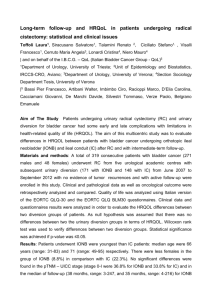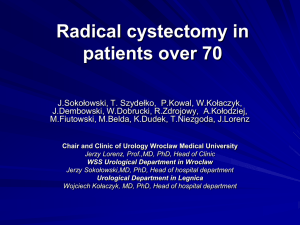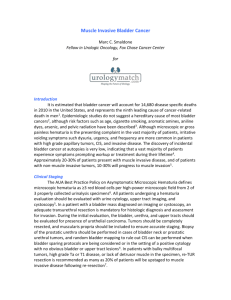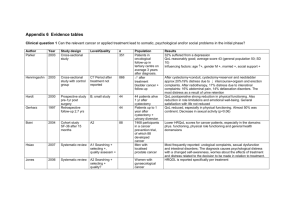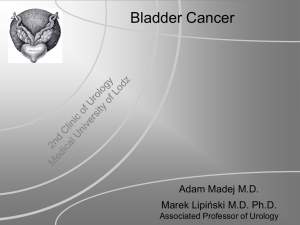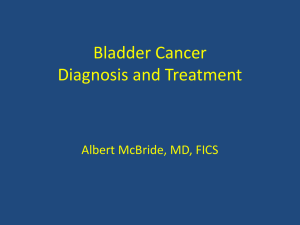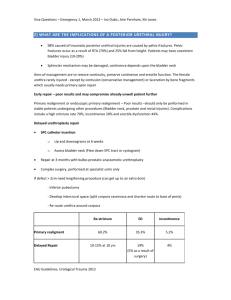Radical Cystectomy for Urothelial Carcinoma of the Bladder
advertisement
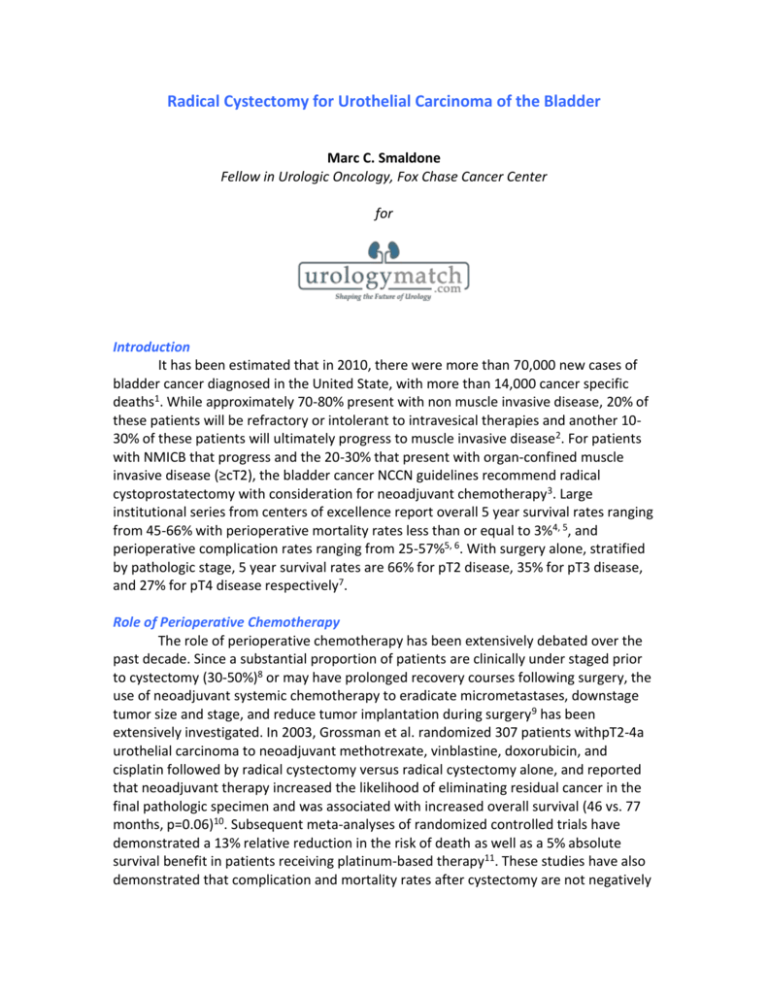
Radical Cystectomy for Urothelial Carcinoma of the Bladder Marc C. Smaldone Fellow in Urologic Oncology, Fox Chase Cancer Center for Introduction It has been estimated that in 2010, there were more than 70,000 new cases of bladder cancer diagnosed in the United State, with more than 14,000 cancer specific deaths1. While approximately 70-80% present with non muscle invasive disease, 20% of these patients will be refractory or intolerant to intravesical therapies and another 1030% of these patients will ultimately progress to muscle invasive disease2. For patients with NMICB that progress and the 20-30% that present with organ-confined muscle invasive disease (≥cT2), the bladder cancer NCCN guidelines recommend radical cystoprostatectomy with consideration for neoadjuvant chemotherapy3. Large institutional series from centers of excellence report overall 5 year survival rates ranging from 45-66% with perioperative mortality rates less than or equal to 3%4, 5, and perioperative complication rates ranging from 25-57%5, 6. With surgery alone, stratified by pathologic stage, 5 year survival rates are 66% for pT2 disease, 35% for pT3 disease, and 27% for pT4 disease respectively7. Role of Perioperative Chemotherapy The role of perioperative chemotherapy has been extensively debated over the past decade. Since a substantial proportion of patients are clinically under staged prior to cystectomy (30-50%)8 or may have prolonged recovery courses following surgery, the use of neoadjuvant systemic chemotherapy to eradicate micrometastases, downstage tumor size and stage, and reduce tumor implantation during surgery9 has been extensively investigated. In 2003, Grossman et al. randomized 307 patients withpT2-4a urothelial carcinoma to neoadjuvant methotrexate, vinblastine, doxorubicin, and cisplatin followed by radical cystectomy versus radical cystectomy alone, and reported that neoadjuvant therapy increased the likelihood of eliminating residual cancer in the final pathologic specimen and was associated with increased overall survival (46 vs. 77 months, p=0.06)10. Subsequent meta-analyses of randomized controlled trials have demonstrated a 13% relative reduction in the risk of death as well as a 5% absolute survival benefit in patients receiving platinum-based therapy11. These studies have also demonstrated that complication and mortality rates after cystectomy are not negatively impacted by administration of neoadjuvant chemotherapy12. As a result of this data, despite concern for the overtreatment of a small proportion of patients, the NCCN guidelines recommend neoadjuvant chemotherapy in all appropriate patients with ≥pT3 disease, with consideration for use in select patients with pT2 disease as well 3. Adjuvant therapy, which offers the advantage of being administered in only patients with known prognostic factors of recurrence, has shown conflicting results in clinical trials, although a recent pooled analysis of 5 prospective trials suggests that adjuvant therapy may positively impact overall and disease free survival13. In addition, a meta-analysis of 6 randomized trials investigating the use of cisplatin based adjuvant therapy suggested a 25% relative reduction in the risk of death for patients receiving adjuvant therapy versus local therapy alone14. However, these trials were very small with methodological flaws, and these limitations limit the clinical applicability of this data. In addition, approximately 30% of patients suffer from peri-operative complications that may prevent or delay the receipt of adjuvant treatment 15. Regardless of timing of administration, utilization of chemotherapy for patients with advanced urothelial carcinoma remains inappropriately low (11.6% total from 1993-2003), which may be due to patients factors, lack of diffusion into community practice, and agent specific toxicities16. Surgical Technique Radical cystectomy is performed for patients with muscle-invasive carcinoma of the bladder and for some patients with recurrent T1 disease or CIS that has been unresponsive to intravesical chemotherapy. The goal of radical cystectomy is to achieve a surgical cure and can be performed via open or minimally invasive techniques17. On occasion, however, the procedure may be performed as a palliative procedure when the symptoms of the disease are severe. Due to risk of intraoperative hemorrhage all antiplatelet and anticoagulants should be stopped pre-operatively, and preoperative imaging of the chest, abdomen, and pelvis is required to rule out the presence of systemic disease. Extensive bowel preparation has been traditionally recommended in the past, but in contemporary practice is reserved for continent large bowel diversions while more mild preparations are now commonly utilized in patients undergoing ileal or incontinent urinary diversions18. The routine use of a nasogastric tube has also been challenged and is not required in all cases19. Per the AUA guidelines, a first or 2nd generation Cephalosporin or a combination of an Aminoglycoside/Metronidazole or Aztreonam/Clindamycin should be administered within one hour of induction and continued for ≤24 hours for antibiotic prophylaxis20. The bladder is traditionally approached through a vertical midline or transverse pfannenstiel incision. Following mobilization of the space of Retzius, the small bowel is anteriorly retracted. The posterior peritoneum is incised, and the ureters are divided close to the ureterovesical junction. In cases where ureteral involvement is suspected, frozen sections can be utilized to ensure negative margins, although the necessity of routine use has also been questioned21. The posterior retrovesical cul-de-sac is exposed, and the posterior peritoneum is incised to expose the plane between the bladder and the rectum. If the patient is a candidate for a nerve sparing procedure, the neurovascular bundles can be mobilized via either an antegrade or retrograde approach22. The anterior dissection consists of incision of the endopelvic fascia, division of the puboprostatic ligaments, and ligation of the dorsal vein complex. If a concomitant urethrectomy is being performed, proximal urethral dissection is continued distally under the pubis to facilitate perineal dissection. If a continent, orthotopic diversion is being considered, frozen section analysis of the urethra should be performed to ensure a negative margin. Once the vascular pedicles have been ligated and divided (superior and inferior vesical branches of the anterior division of the internal iliac artery) and the urethra has been divided, the specimen is removed. Often a heavy suture is utilized to ligate the proximal urethra/prostatic apex to ensure minimal tumor spillage 23. In an anterior exenteration in a female patient, the bladder is taken en bloc with the uterus, ovaries, and fallopian tubes, as well as a strip of the anterior vagina to ensure adequate staging. Vaginal sparing procedures can be performed in sexually active patients that do not have bulky trigonal or bladder neck disease24. A pelvic lymphadenectomy can be performed either prior to or immediately following bladder removal. Traditionally, the limits of dissection included the genitofemoral nerve (lateral), bifurcation of the common iliac artery (cephalad), the endopelvic fascia (caudal), and the bladder (medial). An “extended” lymphadenectomy includes all lymphatic tissue along the common iliac arteries to the level of the aortic bifurcation, although some surgeons include presacral nodal packets or extend dissection proximally along the aorta to the level of the inferior mesenteric artery23. An extended nodal dissection has been shown to improve survival in patients with either node negative disease as well as limited regional metastatic disease25, and its performance has been proposed as a quality of care measure26. The stomach, jejunum, ileum, and colon have been used to reconstruct the urinary tract following radical cystectomy. The appropriate use of these intestinal segments requires knowledge of their surgical anatomy, techniques of isolating segments of intestine and reconstituting continuity of the enteric tract, the problems and techniques of anastomosing the urinary tract to the intestine, and the complications that occur with use of the intestine27. Although a thorough discussion is beyond the scope of this review, reconstruction options include an incontinent conduit (from either large or small bowel), a cutaneous continent urinary diversion (large bowel), or a continent orthotopic diversions (from either large or small bowel). The decision to use a specific segment of bowel is based on patient specific factors, but each segment of bowel is prone to metabolic disturbances of varying clinical significance28. In general, an ileal conduit incontinent urinary diversion is the simplest diversion to perform and is associated with the fewest intra operative and post operative complications29. It is important to avoid the use of ileum in patients with short bowel syndrome, inflammatory bowel disease, or history of previous abdominal radiation27. In these cases a transverse colon conduit may be preferable, or a sigmoid conduit may be utilized when a colostomy is already planned such during pelvic exenteration. Continent diversions, including ureterosigmoidostomy (which has fallen out of favor), cutaneous catheterizable diversions utilizing the ileocecal valve, and orthotopic diversions in which the “neobladder” is anastomosed to the native urethra can be considered in select patients27. In centers of excellence, continent reconstruction has become the procedure of choice in properly selected patients, with the caveat that patients must be appropriately counseled regarding complication risk and potential need for future revision procedures30. Regardless of diversion type, the most common causes of morbidity and mortality in the immediate perioperative period are related to either the enteric-enteric or uretero-enteric anastmoses. For intestinal anastomoses, it is important to minimize local spillage of enteric contents, preserve the enteric blood supply, and achieve a watertight closure off tension, which can be achieved in a hand sewn or stapled fashion. Factors associated with anastomotic breakdown include poor blood supply, irradiated bowel, local sepsis/abscess from intraperitoneal spillage of enteric contents, and drains placed in close proximity to the suture/staple line27. Uretero-intestinal anastomoses can be performed via either a refluxing or anti-refluxing fashion. Refluxing anastomoses are less likely to stricture, and to date it has not been established that reflux in the absence of obstruction is associated with upper tract deterioration following lower urinary tract reconstruction31. However, principles of successful uretero-intestinal anastomosis include watertight mucosa-mucosa apposition in a tension free manner using fine absorbable suture over a diversion stent to minimize urine leak. Typically the left ureter is brought underneath the sigmoid mesentary and the anastomoses are retroperitonealized27. Post Operative Complications Peri-operative mortality following radical cystectomy in modern series ranges from 1-3%5, while peri-operative complication rates using standardized criteria (such as the Clavien classification system32) approaches 50%6. Pulmonary complications are common and can be minimized by early ambulation, aggressive incentive spirometry and respiratory therapy, and early nasogastric tube removal. Post operative ambulation, use of intermittent pneumatic compression devices, and use of pharmacologic agents including low dose unfractionated heparin or low molecular weight heparin (in select patients at high risk) can be utilized to reduce the risk of deep vein thrombosis and pulmonary embolus33. Wound infections, particularly in obese patients, can be minimized by minimal use of electrocautery and copious irrigation prior to closure. Serious infectious complications requiring an intervention, such as abdominal or pelvic abscess leading to sepsis, are uncommon and are most typically related to urine/enteric anastomotic leak or unrecognized visceral injury. Gastrointestinal complications including ileus or intestinal obstruction are among the most common post operative adverse events reported and range both in severity and the level of treatment required. Less common chronic complications are typically related to tissue ischemia and are specific to the type of urinary diversion employed. Examples include stomal stenosis, enteric fistula, ureteral stricture, bladder neck contracture, and inability to catheterize a cutaneous continent diversion, and often require an operative or interventional radiologic procedure to definitively manage23. References 1. Jemal, A., Siegel, R., Xu, J. et al.: Cancer statistics, 2010. CA Cancer J Clin, 60: 277, 2010 2. Hall, M. C., Chang, S. S., Dalbagni, G. et al.: Guideline for the management of nonmuscle invasive bladder cancer (stages Ta, T1, and Tis): 2007 update. J Urol, 178: 2314, 2007 3. Montie, J. E., Clark, P. E., Eisenberger, M. A. et al.: Bladder cancer. J Natl Compr Canc Netw, 7: 8, 2009 4. Dalbagni, G., Genega, E., Hashibe, M. et al.: Cystectomy for bladder cancer: a contemporary series. J Urol, 165: 1111, 2001 5. Stein, J. P., Lieskovsky, G., Cote, R. et al.: Radical cystectomy in the treatment of invasive bladder cancer: long-term results in 1,054 patients. J Clin Oncol, 19: 666, 2001 6. Svatek, R. S., Fisher, M. B., Matin, S. F. et al.: Risk factor analysis in a contemporary cystectomy cohort using standardized reporting methodology and adverse event criteria. J Urol, 183: 929, 2010 7. Herr, H. W., Dotan, Z., Donat, S. M. et al.: Defining optimal therapy for muscle invasive bladder cancer. J Urol, 177: 437, 2007 8. Dutta, S. C., Smith, J. A., Jr., Shappell, S. B. et al.: Clinical under staging of high risk nonmuscle invasive urothelial carcinoma treated with radical cystectomy. J Urol, 166: 490, 2001 9. Jacobs, B. L., Lee, C. T., Montie, J. E.: Bladder cancer in 2010: how far have we come? CA Cancer J Clin, 60: 244, 2010 10. Grossman, H. B., Natale, R. B., Tangen, C. M. et al.: Neoadjuvant chemotherapy plus cystectomy compared with cystectomy alone for locally advanced bladder cancer. N Engl J Med, 349: 859, 2003 11. Neoadjuvant chemotherapy in invasive bladder cancer: update of a systematic review and meta-analysis of individual patient data advanced bladder cancer (ABC) meta-analysis collaboration. Eur Urol, 48: 202, 2005 12. Winquist, E., Kirchner, T. S., Segal, R. et al.: Neoadjuvant chemotherapy for transitional cell carcinoma of the bladder: a systematic review and metaanalysis. J Urol, 171: 561, 2004 13. Ruggeri, E. M., Giannarelli, D., Bria, E. et al.: Adjuvant chemotherapy in muscle-invasive bladder carcinoma: a pooled analysis from phase III studies. Cancer, 106: 783, 2006 14. Adjuvant chemotherapy for invasive bladder cancer (individual patient data). Cochrane Database Syst Rev: CD006018, 2006 15. Donat, S. M., Shabsigh, A., Savage, C. et al.: Potential impact of postoperative early complications on the timing of adjuvant chemotherapy in patients undergoing radical cystectomy: a high-volume tertiary cancer center experience. Eur Urol, 55: 177, 2009 16. David, K. A., Milowsky, M. I., Ritchey, J. et al.: Low incidence of perioperative chemotherapy for stage III bladder cancer 1998 to 2003: a report from the National Cancer Data Base. J Urol, 178: 451, 2007 17. Chade, D. C., Laudone, V. P., Bochner, B. H. et al.: Oncological outcomes after radical cystectomy for bladder cancer: open versus minimally invasive approaches. J Urol, 183: 862, 2010 18. Shafii, M., Murphy, D. M., Donovan, M. G. et al.: Is mechanical bowel preparation necessary in patients undergoing cystectomy and urinary diversion? BJU Int, 89: 879, 2002 19. Inman, B. A., Harel, F., Tiguert, R. et al.: Routine nasogastric tubes are not required following cystectomy with urinary diversion: a comparative analysis of 430 patients. J Urol, 170: 1888, 2003 20. Wolf, J. S., Jr., Bennett, C. J., Dmochowski, R. R. et al.: Best practice policy statement on urologic surgery antimicrobial prophylaxis. J Urol, 179: 1379, 2008 21. Raj, G. V., Tal, R., Vickers, A. et al.: Significance of intraoperative ureteral evaluation at radical cystectomy for urothelial cancer. Cancer, 107: 2167, 2006 22. Kessler, T. M., Burkhard, F. C., Studer, U. E.: Clinical indications and outcomes with nerve-sparing cystectomy in patients with bladder cancer. Urol Clin North Am, 32: 165, 2005 23. Nieh, P. T., Marshall, F. F.: Surgery of Bladder Cancer. In: CampbellsWalsh Urology, 9th Edition. Edited by A. J. Wein, L. R. Kavoussi, A. C. Novick et al.: Saunders, pp. 2479-2505, 2006 24. Chang, S. S., Cole, E., Cookson, M. S. et al.: Preservation of the anterior vaginal wall during female radical cystectomy with orthotopic urinary diversion: technique and results. J Urol, 168: 1442, 2002 25. Herr, H. W., Bochner, B. H., Dalbagni, G. et al.: Impact of the number of lymph nodes retrieved on outcome in patients with muscle invasive bladder cancer. J Urol, 167: 1295, 2002 26. Cooperberg, M. R., Porter, M. P., Konety, B. R.: Candidate quality of care indicators for localized bladder cancer. Urol Oncol, 27: 435, 2009 27. Dahl, D. M., McDougal, W. S.: Use of Intestinal Segments in Urinary Diversion. In: Campbells-Walsh Urology, 9th Edition. Edited by A. J. Wein, L. R. Kavoussi, A. C. Novick et al.: Saunders, pp. 2534-2578, 2006 28. Tanrikut, C., McDougal, W. S.: Acid-base and electrolyte disorders after urinary diversion. World J Urol, 22: 168, 2004 29. Shimko, M. S., Tollefson, M. K., Umbreit, E. C. et al.: Long-term complications of conduit urinary diversion. J Urol, 185: 562, 2011 30. Hautmann, R. E., de Petriconi, R. C., Volkmer, B. G.: 25 years of experience with 1,000 neobladders: long-term complications. J Urol, 185: 2207, 2011 31. Skinner, E. C., Skinner, D. G.: Does reflux in orthotopic diversion matter? A randomized prospective comparison of the Studer and T-pouch ileal neobladders. World J Urol, 27: 51, 2009 32. Dindo, D., Demartines, N., Clavien, P. A.: Classification of surgical complications: a new proposal with evaluation in a cohort of 6336 patients and results of a survey. Ann Surg, 240: 205, 2004 33. Forrest, J. B., Clemens, J. Q., Finamore, P. et al.: AUA Best Practice Statement for the prevention of deep vein thrombosis in patients undergoing urologic surgery. J Urol, 181: 1170, 2009 Marc C. Smaldone, MD Fellow in Urologic Oncology, Fox Chase Cancer Center


